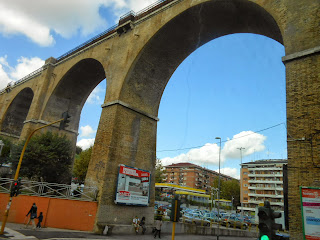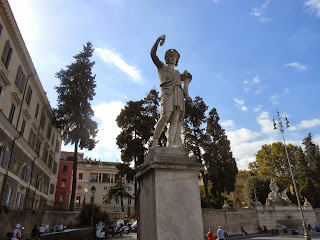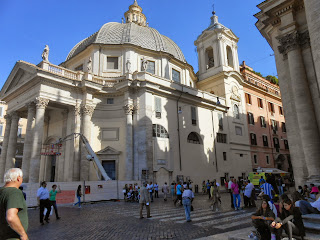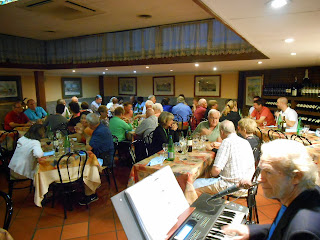Doug and I took a trip to Italy for our 2nd Anniversary. It was the trip of a lifetime! I will be sharing the cities we visited and many, many photos. A picture is worth a thousand words. Right? We traveled with a tour group, Globus (Every journey tells a story), and I must say that for us it worked out very well. One of the advantages of traveling with a group is that you can see the famous tourist attractions without standing in line for 3 or more hours. We made a lot of friends and the details of our trip were left with our Tour Director, Ornella. We wanted to see the famous places anyway, so it was very memorable and fun.
Saturday, September 14th
We left our house on Saturday, September 14th and headed for our hotel near Chicago. We were flying from Chicago O'Hare International Airport. The road trip was spent texting family and friends and letting them know we were on our way. At that point, I only knew some limited Italian, like "ciao" and "grazie". It was enough to make it to Chicago.
Sunday, September 15th
Doug waiting to board the plane from Charles de Gaulle Airport in Paris, France,
to the Leonardo da Vinci Airport (Fiuminco) in Rome, Italy.
Our flight left about 10:10 AM and we arrived around 12:15 PM. It was a clear sunny day with great visibility. We enjoyed flying Air France. The food and hospitality were great.
The Fiumicino Airport in Rome, Italy. Our representative from Globus Tours met us at the airport and took us to our hotel. The airport is about 19 miles away from Rome.
 |
| Scenic view on the way to our hotel. Roman arches, (not golden arches)! |
 |
| Crossing the Tiber River. In Rome! |
Piazza del Popolo

The Chigi Chapel—in Santa Maria del Popolo-from left: Sigismondo Chigi's tomb, Lorenzetto/Raphael's Jonah, Sebastiano del Piombo's painting, Bernini's Habakuk and the Angel, and Agostino Chigi's tomb (Photo by Francesco Gasparetti)
(photo from: http://www.reidsitaly.com/destinations/lazio/rome/sights/sm_popolo.html#sthash.f5cHYd61.dpuf )

The preserved chapel with the works by Caravaggio and Carracci
in Rome's Santa Maria del Popolo.
(photo from: http://www.reidsitaly.com/destinations/lazio/rome/sights/sm_popolo.html#sthash.f1xD5LiR.dpuf )

Frescoes by Pinturicchio.
(photo from reidsitaly.com)

Caravaggio's "Crucifixion of St. Peter" (1602) in Rome's Santa Maria del Popolo.
(photo from: http://www.reidsitaly.com/destinations/lazio/rome/sights/sm_popolo.html#sthash.f1xD5LiR.dpuf )
Views of Rome near Piazza del Popolo
Piazza del Popolo is a large urban square in Rome. The name means "People's Square".
It
was originally laid out in 1538 to provide a grandiose entrance to
the city – at the time, and for centuries before, it was the main
northern gateway into the city. Since then it has been extensively
altered, most recently by Giuseppe Valadier in 1823. Guarding its
southern entrance are Carlo Rainaldi’s twin 17th-century baroque
churches, Chiesa
di Santa Maria dei Miracoli and Chiesa
di Santa Maria in Montesanto,
while over on the northern flank is the Porta
del Popolo,
created by Bernini in 1655. In the centre, the 36m-high
Egyptian obelisk was
moved here from the Circo Massimo in the mid-16th century. To the
east are the Pincio
Hill Gardens.
Read more: http://www.lonelyplanet.com/italy/rome/sights/square-plaza/piazza-del-popolo#ixzz2gWM9D47I
Read more: http://www.lonelyplanet.com/italy/rome/sights/square-plaza/piazza-del-popolo#ixzz2gWM9D47I
 |
| An Egyptian obelisk of Pharaoh Ramses II from Heliopolis stands in the center of the Piazza. It is the second oldest and one of the tallest in Rome. It was brought to Rome in 10 BC. (wikipedia.org) This is a view of another church on the Piazza, the Santa Maria del Popolo. It is located near the Porta del Popolo where it was built in 1477. The church contains many impressive works of art, including Rome's oldest stained-glass windows and two famous paintings by Caravaggio. The Chigi chapel was created by Raphael and there are fifteenth-century frescoes in the Della Rovere chapel. (www.aviewoncities.com) The only Roman work by Guillaume de Marcillat (1509), the undisputed French master of stained glass, depicts the Infancy of Christ and Life of the Virgin. (photo from: http://womenworld.org/travel/rome-s-top-10---santa-maria-del-popolo.aspx ) |
The Chigi Chapel—in Santa Maria del Popolo-from left: Sigismondo Chigi's tomb, Lorenzetto/Raphael's Jonah, Sebastiano del Piombo's painting, Bernini's Habakuk and the Angel, and Agostino Chigi's tomb (Photo by Francesco Gasparetti)
(photo from: http://www.reidsitaly.com/destinations/lazio/rome/sights/sm_popolo.html#sthash.f5cHYd61.dpuf )
The preserved chapel with the works by Caravaggio and Carracci
in Rome's Santa Maria del Popolo.
(photo from: http://www.reidsitaly.com/destinations/lazio/rome/sights/sm_popolo.html#sthash.f1xD5LiR.dpuf )
Frescoes by Pinturicchio.
(photo from reidsitaly.com)
Caravaggio's "Crucifixion of St. Peter" (1602) in Rome's Santa Maria del Popolo.
(photo from: http://www.reidsitaly.com/destinations/lazio/rome/sights/sm_popolo.html#sthash.f1xD5LiR.dpuf )
 |
| Doug is sitting in front of the Fontana del Nettuno, Fountain of Neptune. Neptune is between two tritons. The sculpture is by Giovanni Ceccarini. (wikipedia.org) |
 |
| Sixteen Sphinxes decorate the oval boundary walls built around the Piazza. (www.waymarking.com) |
 |
| Allegorical sculpture (Autumn) by Achille Stocchi. |
 |
| Santa Maria dei Miracoli built 1675-79. |
 |
| Santa Maria in Montesanto built 1662-75. Symmetrical Churches At the southern end of the square are two symmetrical churches on either side of the Via del Corso, a street leading straight through the heart of Rome to Piazza Venezia. The churches, Santa Maria dei Miracoli and the Santa Maria in Montesanto were commissioned by Pope Alexander VII in 1658. They were both designed by Carlo Rainaldi. The churches are not identical since the surface area of the plot provided for the Santa Maria in Montesanto was smaller. In order to give the impression of symmetry, Rainaldi created an oval dome for this church and a circular dome for the Santa Maria dei Miracoli. (http://www.aviewoncities.com/rome/piazzadelpopolo.htm) |
Views of Rome near Piazza del Popolo
Mausoleo di Augusto
Once one of Ancient Rome's most imposing monuments and one of the most prestigious burial places in Rome, this is now an unkempt mound of earth, overgrown with weeds and surrounded by fences. The mausoleum, which was built in 28 BC., is the last resting place of Augustus, who was buried there in AD. 14, and his favorite nephew and heir, Marcellus. Mussolini had it restored in 1936.
Typical transportation and parking in Rome.
Welcome to Rome Dinner
Welcome to Rome Dinner
Italian Meal Times:
In the summer, Italians usually eat fairly late meals. Lunch will not start before 1:00 and dinner not before 8:00. Restaurants close between lunch and dinner. In large tourist areas, restaurants will be open all afternoon. Away from the cities and tourist areas, nearly all the shops are closed in the afternoon for three to four hours, roughly from 1:00 to 4:00. The families have their big meal of the day then. During the school year, the children get out of school and go home to eat with the family. There is time to nap and work on homework. Workers return to their jobs until 7:00 or 8:00 at night.
http://goitaly.about.com/od/foodandwineofitaly/p/eatingout.htm
We were greeted to Rome with a special welcome dinner at Le Due Fontanelle ("Two Fountains"). It was a traditional four course meal. Food is a very important part of Italian culture. Our first meal in Rome was a real pleasure, great food and great traveling companions. We dined in true Roman style!http://goitaly.about.com/od/foodandwineofitaly/p/eatingout.htm
Le Due Fontanelle
 |
| Salute! (Health!) Cin Cin! (Cheers!) |
 |
| Our traveling companions. Jack & Sharon and Debbie & Jack. |
 |
| Delizios Pasta! |
|
Il Secondo
The main course is the second course. Chicken, meat, or fish are the usual choices.
I chose chicken in mushrooms and artichokes with salad and green beans.
Most Italians drink wine, vino, and mineral water with their meal.
A dolce (or sweet) ends a traditional Italian meal. This was a light cake with fresh fruit and mascarpone filling. Bella! Our traveling companions. Caffe Coffee is drunk at the end of the meal. We call it expresso; a small cup of very strong coffee. We were often asked if we wanted "American Coffee". It is a long coffee. They'll let the water pour from the machine until the coffee becomes weak and bitter. It is called Caffe Americano which is also expressesd as acqua sporca, or "dirty water" by Italians. http://goitaly.about.com/od/foodandwineofitaly/a/italian_coffee.htm The beautiful city of Rome at night, walking back to our hotel. Buona notte e sogni d'oro. |


























Love the sites ! Looking forward to learning more of your trip. Interesting summary of each picture.
ReplyDelete